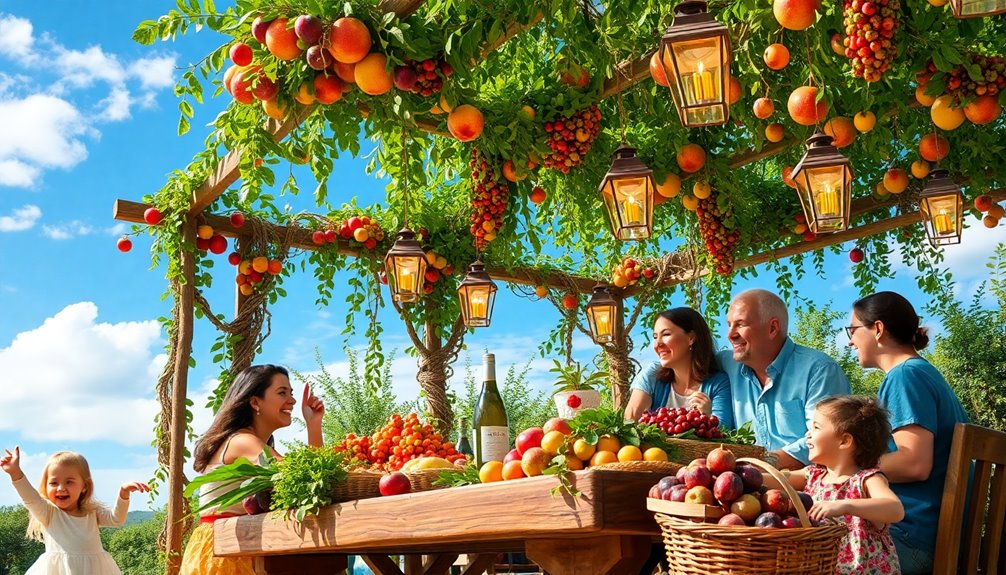The Feast of Booths, also known as Sukkot, is a lively Jewish festival celebrating the harvest and the Israelites' 40-year journey in the wilderness. You celebrate by building temporary shelters called sukkot, which remind you of life's fragility and your dependence on God. The festival lasts for eight days, starting on the 15th of Tishri, and includes joyful communal meals and rituals like waving the Four Species. It strengthens community ties and fosters gratitude for both the harvest and divine provision. If you're curious about the traditions and significance behind Sukkot, there's much more to explore.
Key Takeaways
- The Feast of Booths, or Sukkot, commemorates the Israelites' 40 years in the wilderness after the Exodus.
- It begins on the 15th of Tishri and lasts for eight days, concluding with Shemini Atzeret.
- Sukkot celebrates the harvest and gratitude for God's provision, marked by building temporary shelters called sukkot.
- Rituals include the waving of the Four Species and inviting ushpizin, symbolizing hospitality and community.
- The festival emphasizes joy, communal gatherings, and spiritual reflection on blessings received throughout the year.
Introduction
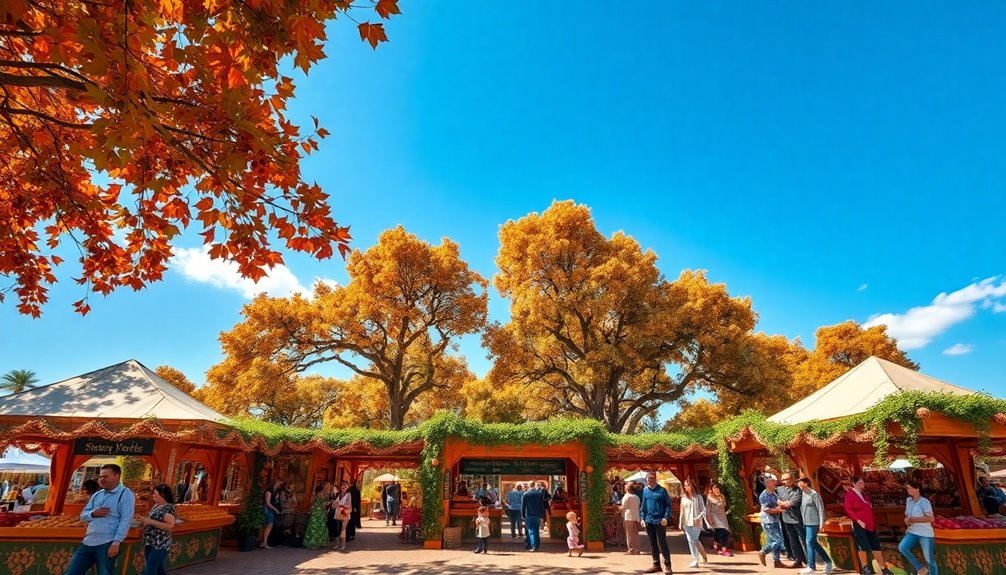
The Feast of Booths, or Sukkot, is one of the most significant festivals in Judaism, observed on the 15th day of Tishri. This vibrant celebration lasts for eight days and commemorates the Israelites' journey through the wilderness after their Exodus from Egypt.
As you participate in Sukkot, you'll notice it marks the end of the agricultural year in Israel, emphasizing gratitude for the harvest and recognition of God's provision.
During this festival, you'll build temporary shelters called sukkot, which symbolize the fragile dwellings of the Israelites during their forty years in the desert. These booths are often adorned with natural materials and fruits, inviting a sense of connection to nature and tradition.
Throughout Sukkot, you'll engage in rituals like waving the Four Species—palm frond, willow branch, myrtle branch, and citron—and reciting Hallel, a collection of Psalms of praise.
Sukkot serves as a reminder of God's protection and provision, encouraging communal gatherings and hospitality.
As you reflect on the transient nature of life, you'll find deeper meaning in this joyous celebration, fostering a sense of belonging and gratitude within your community.
Biblical Basis for Sukkot
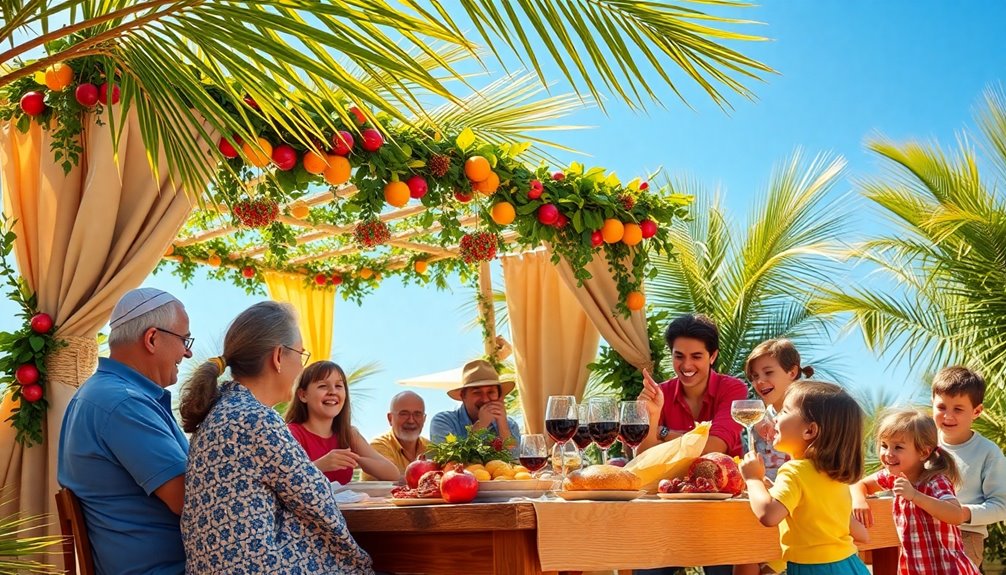
When you explore the biblical basis for Sukkot, you'll find key references in Leviticus 23, Exodus, and Deuteronomy that highlight its significance.
These passages not only outline the festival's observance but also emphasize its agricultural roots and the importance of pilgrimage.
Understanding these scriptures will enrich your appreciation of this meaningful celebration.
Primary Bible References
Sukkot's biblical foundation is rooted in several key passages that outline its significance and practices. The Feast of Booths, or Sukkot, is mandated in Leviticus 23:34-44, where it describes a festival lasting seven days, starting on the 15th day of the seventh month, Tishri. This festival, also known as the Festival of Ingathering, marks the end of the agricultural year, as noted in Exodus 23:16 and Exodus 34:22.
Deuteronomy 16:13-15 emphasizes the joy and thanksgiving associated with Sukkot, instructing families and the Levites to celebrate together. This focus on communal joy highlights the festival's importance in fostering unity and gratitude.
Additionally, Numbers 29:12-38 outlines specific sacrifices and offerings to be made during the festival, underscoring its significance in ancient Israel's worship practices.
Moreover, Zechariah 14:16-19 prophesies that all nations will one day observe Sukkot, emphasizing its eschatological importance and connection to the messianic age.
These passages collectively illustrate Sukkot's rich biblical heritage and its enduring relevance in Jewish tradition.
Secondary Bible References
While Sukkot is primarily rooted in the Torah, secondary biblical references further enrich its significance and practices. The Feast of Booths, or Sukkot, is deeply tied to the themes of provision in the wilderness, as seen in Exodus, where God provided sustenance to the Israelites. This celebration not only marks the harvest season, reflecting its agricultural roots, but also emphasizes communal worship—highlighted in Numbers, which details specific offerings to enhance the festival experience.
Zechariah 14:16-19 introduces an eschatological significance to Sukkot, linking it to the future gathering of nations to worship God. This prophetic vision adds depth to the observance, suggesting that Sukkot extends beyond mere remembrance of past events.
Furthermore, in the New Testament, Jesus' participation during the Feast of Tabernacles, as recorded in John 7:2-14, reveals His declaration as the source of rivers of living water. This connection underscores the spiritual dimensions of Sukkot, inviting you to reflect on both the physical and spiritual sustenance provided by God throughout history.
Thus, these secondary references help you appreciate Sukkot's rich tapestry of meaning and its relevance in both ancient and contemporary contexts.
Agricultural Harvest Celebration Roots
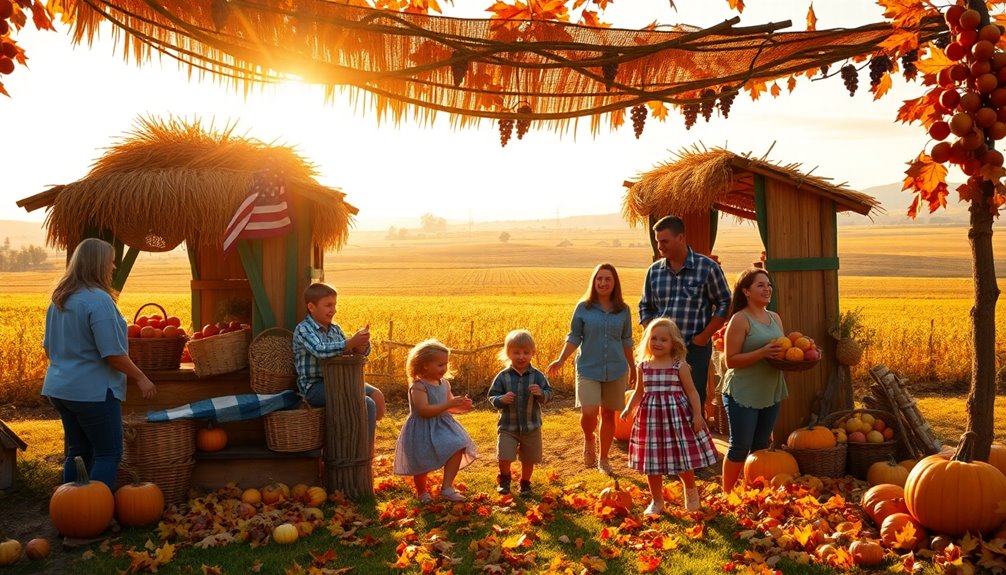
The Feast of Booths, or Sukkot, is deeply rooted in agricultural celebration, marking the end of the harvest year in Israel. This vibrant festival honors the completion of the agricultural harvest, particularly the gathering of seven major crops mentioned in Deuteronomy 8:8.
Historically referred to as the Festival of Ingathering, Sukkot emphasizes the connection between community and agriculture, showcasing gratitude for God's provision.
During this time, you'll see families constructing temporary shelters, or sukkot, as a way to remember the Israelites' dependence on God for sustenance during their wilderness journey. These shelters serve as a reminder of the fragility and transience of life, encouraging you to appreciate the blessings of the harvest.
As you celebrate the Feast, you'll likely engage in the ritual of waving the Four Species—palm frond, willow branch, myrtle, and citron (etrog)—a symbolic act of thanksgiving for the agricultural bounty.
Each day of the festival includes special offerings made by fire to the Lord, highlighting the communal spirit of Sukkot and the importance of recognizing the abundance provided through the agricultural harvest.
Cultural Significance of Sukkot
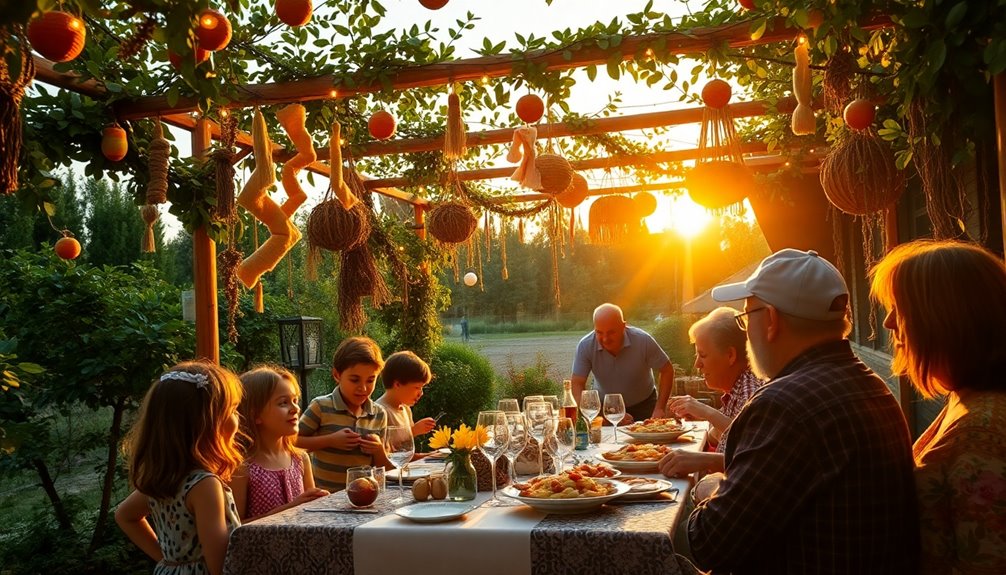
Celebrating Sukkot brings communities together, emphasizing hospitality and connection among families and friends. Known as the Feast of Booths, this vibrant festival invites you to experience the joy of Ushpizin, where you welcome guests into your sukkah to share meals and blessings.
It's a time when the spirit of hospitality transforms your home into a gathering space, strengthening bonds within your community.
Sukkot also reflects deep cultural roots tied to ancient agricultural practices, marking the end of the harvest season. This connection to the land fosters a sense of gratitude and reinforces the significance of communal gatherings.
During this time, you may find yourself participating in lively parades and communal worship, echoing the unity felt during the Temple period.
Moreover, Sukkot encourages environmental awareness, urging people to use natural materials for their sukkot and adopt eco-friendly practices.
This commitment to sustainability not only supports the environment but also reinforces cultural identity. The creativity involved in decorating sukkot with fruits and artistic elements showcases your heritage, making Sukkot a celebration rich in tradition and meaning.
Misunderstanding Sukkot's Duration
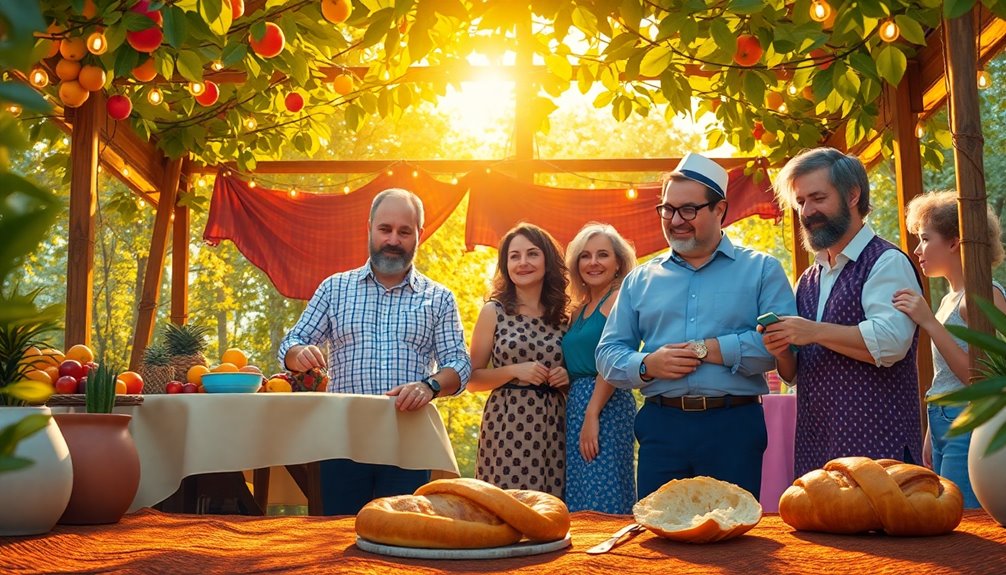
Many people think Sukkot is just a one-day celebration, but it actually lasts a full week.
This misunderstanding can lead to missed opportunities for deeper connection with its rituals and symbolism.
Address Common Misconceptions
Understanding Sukkot's duration can be tricky, especially when you hear about the festival's seven days in Israel and the additional day often observed by Jewish communities in the diaspora. Many people mistakenly think Sukkot lasts just one week, but that's not the whole story.
While the Feast of Booths officially spans seven days, it wraps up with Shemini Atzeret, which some confuse with Sukkot's last day.
It's important to realize that the first and last days are holy convocations, prohibiting work, while the intermediate days, known as Chol HaMoed, allow for certain activities.
Another misconception is that Sukkot is only a harvest festival. In reality, it commemorates the Israelites' 40 years of wandering in the desert, highlighting our dependence on God's provision.
Throughout these seven days, you'll find rituals like dwelling in the sukkah and waving the Four Species, which emphasize Sukkot's significance beyond just the initial celebrations.
Remembering these details will deepen your understanding and appreciation of this beautiful festival. By clearing up these misconceptions, you can fully embrace the spirit of Sukkot.
Misinterpretation of Sukkot's Symbolism
Sukkot's symbolism often gets overshadowed by its duration and the confusion surrounding it. Known as the Feast of Booths, Sukkot spans eight days, starting on the 15th of Tishri.
While the festival primarily lasts for seven days, the eighth day, Shemini Atzeret, is often misinterpreted as a separate celebration. This misunderstanding can lead you to overlook the significance of the eighth day, which is a time for spiritual reflection and gratitude.
The agricultural roots of Sukkot connect both the seven days of joyous harvest and the eighth day, which marks a transition from festive celebration to a deeper personal connection with God.
When you fail to recognize Shemini Atzeret's importance, you miss out on the full experience of Sukkot. The day emphasizes unity, community, and the hope for future blessings through prayer.
Community Harvest Celebrations
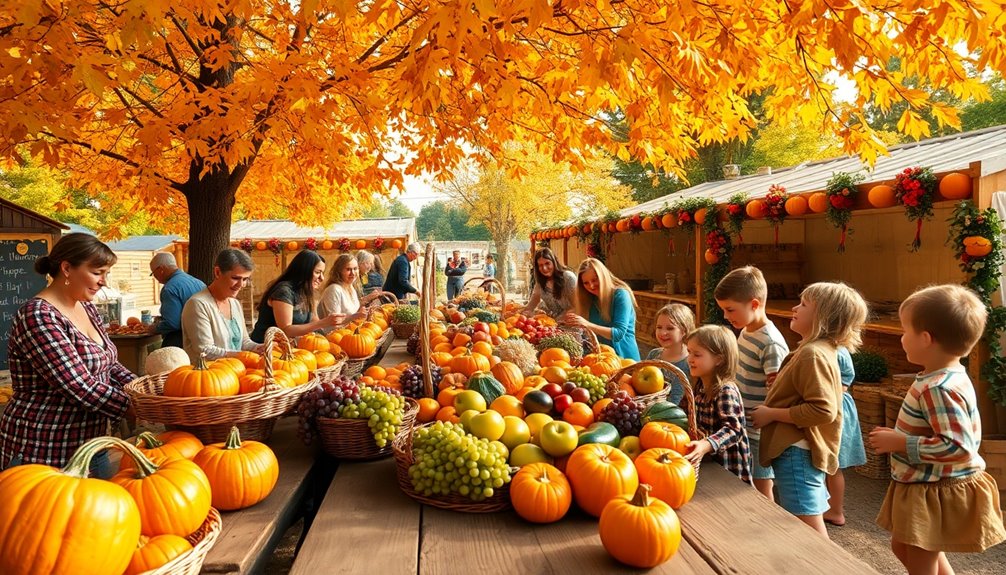
As you gather with your community during Sukkot, you'll notice how gratitude plays a central role in the harvest celebrations.
Participating in a group harvest thanksgiving service not only strengthens bonds but also reminds everyone of the blessings received throughout the year.
These shared moments create a sense of unity and appreciation for both the land and each other.
Reflect on Gratitude Practices
The Feast of Booths, or Sukkot, invites you to engage in meaningful gratitude practices that celebrate community and harvest. During this festival, families gather in temporary shelters called sukkot to express their thankfulness for God's provision throughout the agricultural year.
You'll find that festive meals in the sukkah are a beautiful way to share food and fellowship, highlighting the importance of hospitality in fostering a sense of community.
Every day of Sukkot, rituals like daily offerings and prayers, including the recitation of Hallel, reinforce collective gratitude for the bountiful harvest. As you participate in these practices, consider the custom of inviting ushpizin, or honored guests, into the sukkah. This act symbolizes welcoming others into your celebration of gratitude, deepening community bonds through shared experiences.
Additionally, historical observances, such as the water-pouring ceremony at the Temple, emphasize communal joy and gratitude for rain and sustenance.
These elements remind you of the festival's agricultural roots and its significant role in nurturing community spirit. By reflecting on these gratitude practices, you embrace the essence of Sukkot, reinforcing connections with those around you.
Group Harvest Thanksgiving Service
During the Feast of Booths, communities come together to celebrate the Group Harvest Thanksgiving Service, a vibrant expression of gratitude for the agricultural bounty. This celebration highlights communal gratitude, allowing you and your neighbors to reflect on God's provision during this significant season in Israel's agricultural calendar.
In many communities, families gather in sukkahs, sharing festive meals that emphasize hospitality and unity. The atmosphere is filled with joy as you participate in rituals like reciting prayers and blessings, alongside the waving of the Four Species—lulav, etrog, myrtle, and willow. These acts symbolize your appreciation for the harvest and all that the land provides.
The Group Harvest Thanksgiving Service also features music, dance, and cultural activities that strengthen community bonds, echoing the historical practices tied to the Temple in Jerusalem.
These gatherings aren't just about celebration; they serve as an opportunity for outreach and education, promoting understanding of Sukkot's significance. You're encouraged to engage in global mission efforts and environmental stewardship, ensuring that the spirit of gratitude extends beyond the feast and into everyday life.
Harvesting Communal Gratitude
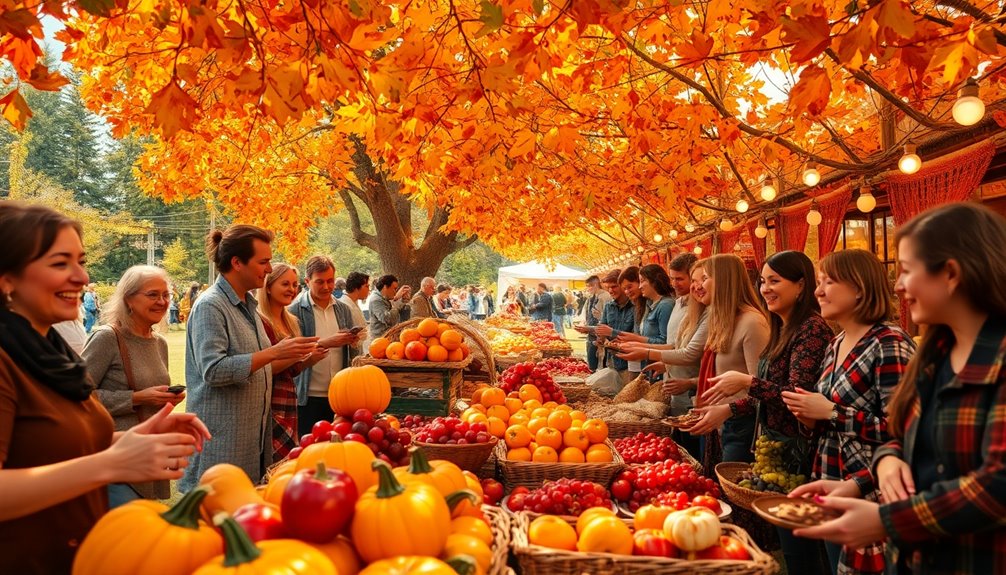
While celebrating the Feast of Booths, communities come together to express gratitude for the harvest in a vibrant and meaningful way. This festival, also known as Sukkot, marks the end of the agricultural year in Israel, highlighting God's provision and the bounty that sustains life.
Families construct temporary shelters, or sukkot, where they host communal gatherings, sharing festive meals that foster a sense of hospitality and connection.
During this eight-day celebration, participants engage in rituals like waving the Four Species, symbolizing the unity of the Jewish people and their gratitude for the seasonal harvest. Daily offerings and communal prayers strengthen the collective expression of appreciation, allowing everyone to reflect on the blessings received throughout the year.
Sukkot encourages acts of kindness, inviting friends and strangers alike to join in the meals and festivities, reinforcing social bonds.
Additional Resources
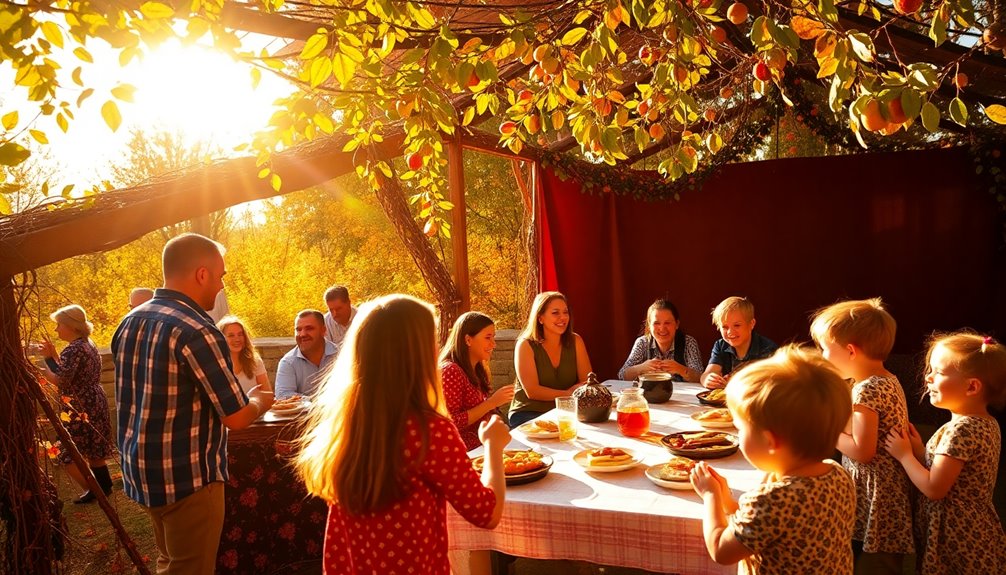
Celebrating the Feast of Booths can be even more enriching with the right resources at your fingertips.
You'll find numerous online platforms offering comprehensive information about the Feast of Tabernacles, detailing its historical significance, rituals, and contemporary practices. Dive into academic journals that explore the theological implications and historical context of Sukkot, providing deep insights into how Jewish people observe this important festival.
Books like "The Jewish Festivals" by Hayyim Schauss give you detailed descriptions and analyses of customs and rituals, enhancing your understanding of its cultural context.
Additionally, community programs hosted by Jewish and interfaith organizations often engage participants in building sukkahs and celebrating the festival together, fostering a sense of belonging.
Documentaries and educational videos available on streaming platforms offer visual and narrative accounts of Sukkot, illustrating the festival's rituals and the communal spirit that Scripture has said God desires.
With these resources, you can better appreciate the significance of the Feast of Booths and its rich traditions, fostering a deeper connection to the celebration and its meaning for both the Jewish people and the broader community.
Frequently Asked Questions
What Is the Feast of Booths in John 7?
In John 7, you see a vibrant celebration where Jesus engages with the crowd, teaching and challenging the religious leaders.
This event showcases His boldness as He connects deeply with the people. As you read, you can sense the significance of water and light, symbols of spiritual sustenance and guidance.
Jesus invites those who thirst for truth to come to Him, revealing His identity and mission amid the festivities.
How Do Jews Celebrate the Feast of Booths Today?
Today, Jews celebrate by building temporary shelters called sukkot, where you can enjoy meals and sometimes sleep.
You'll often see families decorating their sukkot with fruits, vegetables, and artwork, highlighting hospitality and community.
During this festive time, you might participate in daily prayers and blessings, wave the Four Species, and join public celebrations.
In Israel, many businesses close for community activities, fostering unity and tradition among families and friends.
What Is Forbidden During Sukkot?
During Sukkot, you'll find that certain activities are forbidden to enhance the holiday's sanctity.
You can't engage in melacha, or creative work, especially on the first and eighth days.
Using electric devices is discouraged, and eating meals outside the sukkah isn't allowed.
You'll also want to avoid leavened bread on the first day, and limit choreographed entertainment to maintain focus on spiritual reflection and community worship.
Is Pentecost the Feast of Booths?
No, Pentecost isn't the Feast of Booths. They're distinct celebrations in the Jewish calendar.
Pentecost, or Shavuot, occurs 50 days after Passover, celebrating the giving of the Torah and the wheat harvest.
In contrast, the Feast of Booths, or Sukkot, marks the end of the harvest season and remembers the Israelites' journey in the wilderness.
Each festival carries its own unique significance, customs, and agricultural themes, reflecting different aspects of Jewish tradition.

